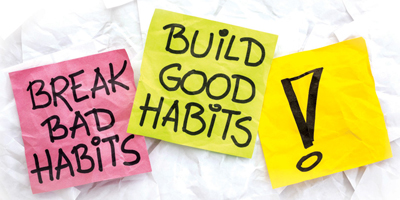
Around 40 per cent of people with disabilities report long-term difficulties with sleep. Furthermore, sleep problems are three times more common in people with chronic conditions such as traumatic brain injury, spinal cord injury, multiple sclerosis, post-traumatic stress disorder and Parkinson’s disease than in the general population.
Need to get a good night’s sleep?
As you can see, sleep problems are fairly common. In fact, one in four people experience sleep difficulties, which include trouble falling or staying asleep, early-morning waking, sleeping too much and restless or unsatisfying sleep. But getting a good night’s rest can improve your mental well-being and help you to better manage anxiety. The good news is that there are several things you can do to improve the situation.
Create a comfortable sleep environment
If you want to have a good night’s sleep, it helps to create a comfortable environment. Make sure you have a supportive mattress and fresh bedding. Ensure that your room isn’t too hot or cold, minimize noise and block out light.
Relax
Do something to relax your body and mind before hitting the hay, such as taking a hot bath around 90 minutes before your planned bedtime. Or try a relaxation exercise, meditation or listening to calming music.
Have a snack
Although a heavy meal late in the evening can disrupt sleep, a light, healthy snack in the evening can improve your night’s rest. Examples include light cheese and crackers, bananas or a warm glass of milk. Avoid heavy, spicy or sugary foods.
Get physical
People who exercise tend to have more restful sleep. Exercising for at least 30 minutes three times a week can improve matters—so get moving! In terms of sleep, the best times to exercise are the late afternoon and early evening. Working out in the morning, while good for you, won’t help with sleep. And exercising less than two hours before bedtime can actually interfere with rest.
Set a bedtime routine
Having a bedtime routine cues your body that it’s time to sleep. So, establish a set routine that you follow every night. For example, have a hot bath, put on your pyjamas, brush your teeth, and then listen to soft music and read on the couch until you start to feel drowsy. Then, go to bed.
Establish a fixed awakening time
Try waking up at the same time every day (even on weekends), no matter how well or how poorly you have slept. This helps your body to get used to a regular sleep rhythm.
Sleep only when sleepy
Don’t force yourself into bed at a particular time if you’re not feeling tired. You’ll only lie awake, frustrated that you can’t nod off.
Just for sleeping
Your bed should be used strictly for sleeping (sex is the only exception). Avoid reading, watching television, working or studying in bed. These activities will keep your mind active, which will get in the way of a good night’s rest.
Get out of bed
If you don’t fall asleep after 20–30 minutes, get out of bed and do something boring (e.g., read the manual on how to program your clock radio or the sports section of the newspaper if you’re not a sports fan) or relax with meditation, listening to calm music or having a warm, caffeine-free drink. When you start to feel sleepy, head back to bed. This strategy can feel like you are making things worse but, if you stick with it, it can really help.
Don’t worry
Leave your concerns about work, school, health and relationships at the bedroom door. Instead, schedule a “worry time” earlier in the evening to think over your problems. If you wake in the middle of the night with thoughts whizzing around your head, try writing down your worries and tell yourself you will deal with them in the morning.
Avoid caffeine, alcohol and smoking
Avoid caffeine (including coffee, some teas, soft drinks and chocolate), alcohol and smoking for at least four hours before bedtime. Although you might think that alcohol will help you doze off, it actually interferes with sleep later in the evening.

Skip the nap
Naps can get in the way of your body’s normal sleep cycle. So, if you’re having trouble sleeping at night, stop taking siestas. That way, your body will be more tired at bedtime.
Get some natural light
Spend some time outdoors or in natural light every day. Getting some sunlight early in the day can help to set your body’s natural wake and sleep cycle.
TIP: Sleep problems can be the result of several conditions or medical problems, such as narcolepsy, restless leg syndrome, bruxism or sleep apnea.
TIP: Worrying about not sleeping doesn’t help—it just makes it more likely that you’ll stay awake. Let go of your belief that you can’t function on less than eight hours a night. Stop looking at the clock and trying to make yourself nod off. It will happen when it happens. 
Keys to success
- Start small! Making small changes can have a large impact on your sleep. Don’t try to do everything at once. Instead, pick one or two strategies and use them consistently. When you’re ready, add a new strategy. The goal is to slowly start increasing behaviours that can help you sleep, while reducing the things that are interfering with your rest.
- Be consistent. Pick a strategy and use it consistently. Do the same thing every night.
- Be patient. These strategies can take time to improve your sleep. In fact, things can sometimes get worse before they get better. Hang in there and stick with it!
- Chart your progress. Use a sleep diary to keep track of the strategies you’re using and your weekly progress.
Adapted with permission from AnxietyBC.
My life with DSPS

What’s that you say, you just can’t wake up in the morning? All six of your alarm clocks go off at 5-10 minute intervals and you don’t even hit snooze, you just don’t hear them? If forced to get up, you have morning sickness? The only way to be absolutely certain you don’t oversleep, is to stay up all night?
When I was a kid, I was told this was mostly my fault: laziness, sloth. It was also my parents’ fault: lousy parenting. It was assumed that any normal person can train her/himself to wake by 8, and no abnormality in this regard was recognized.
Fortunately Circadian Rhythm Disorders are now recognized, though a majority of doctors still don’t know anything about them and the treatments offered often don’t work well.
There are a great many sleep disorders. An official list of them has been pared down to about 70. Many have to do with not getting enough sleep, or getting sleep of poor quality. Some have obvious causes: chronic pain, frequent stops in breathing etc.
People with Circadian Rhythm Disorders usually have perfectly normal “sleep architecture” if allowed to sleep when their bodies say it’s normal to sleep, for example 4:30 a.m. to 1 p.m. Some people with my disorder, DSPS, Delayed Sleep-Phase Syndrome (or Disorder), understood early-on that they’d have to work evenings/nights, either freelance or a job, and avoid morning appointments at all costs. Some are adamant and feisty about it. More power to them; I wish I’d been so wise.
I’m not sure when it began for me, but it was in very early childhood. At our house people went to bed to rest, not to sleep. That terminology was for my sake — no point pretending that all of us would fall asleep within the first few hours. Mom would wake and look in on me at one or two and I’d smile and chirrup “I’m just resting, Mama!” She’d look so ridiculously sleepy.
Come school age, they got me up and to the school bus without me remembering any of that. I was obedient, and got good grades, until I hit my very stormy teens. Then followed some years where I was told that I was smart and wasn’t working to my potential. You try it on three hours sleep, I could have said. But the only answer to that was to tell me to go to bed earlier. Aaargh. Yes, sleep disorders are yet another reason for the underachiever label.
For decades I worked day jobs after sleeping 3:30 to 7:30 a.m., catching up on weekends. Dad used to say what I did was to save up on sleep on the weekends. That worked, except for the many mornings I overslept, as long as youthful resilience lasted. Next step was to add a “nap” 5 to 10 p.m. Wreaks havoc with the social life, but it, along with coffee by the gallon, kept me my job for years. If you can’t be normal, you’re not good enough. You learn to apologize, make excuses, tell lies. No one understands and, when you’ve never heard of DSPS either, you certainly don’t expect them to. You listen politely when people offer advice about how to get to sleep earlier — you’ve tried all that, of course. Depression follows for 50% of us, according to studies. That’s how it was for me at least, after I got resocialized following the impossible teen years. The apologetic habit is engrained and hard to break.
Three and a half years ago, I found a doctor who knows what DSPS is and has treated many of us. Wow, I’m not the only one like this! Learning that it has a name is a life-changing revelation; I was ‘high’ the first six months after diagnosis and spent all my time researching circadian rhythms on the internet. Not just humans, either. I know quite a bit about the circadian activities of fruitflies and rats as well, not to mention how important day-length, and thus seasonal, information is for many animals and birds.
It was hard the first months, as the specialist prescribed “No naps!” and my system no longer knew how to sleep more than five hours at a stretch. Using a light box (10000 lux) in the morning and the hormone melatonin in the late afternoon, we did manage to shift my sleep schedule and I learned to sleep for 7+ hours at a stretch. We were optimistic for 2-3 years. 
I still do my “reboot” two or three times a month: I stay up for 36 hours and can then sleep solidly for 10-12 hours, after which I feel healthier for a few days. The specialist has seen that in others and can’t explain it, but we figure it has to do with the built-in “24-hour day” which in my case is more like 27 hours.
Now he’s declared me “not a success”. When he said that, it took me a few seconds to realize that it is he, not I, who’s been unsuccessful here! We’ve managed to shift only the sleep schedule.
The many other rhythms, such as appetite, best hours of alertness and no doubt many peripheral clocks, have not followed suit. My body knows it’s being fooled and protests in several ways. So I’m now on 60% disability pension and look forward to retirement when I’ll sleep ’til noon the rest of my life. Friends and colleagues just can’t believe that; they think I’ve got it licked and ought to continue to go to bed “at a reasonable hour”. Ha!
Sleeping at the wrong time of day leads, for most of us, to physical and mental illness. DSPS has been likened to permanent jet-lag. Many shift workers have similar problems, and for me the day shift is shift work. Some people get onto the merry-go-round of evening sleeping pills and morning wake-up pills, messing up their systems to the point where a diagnosis may be nearly impossible. I’m very glad I never had a doctor who got me onto sleeping pills!
OK, I’m not writing this to make you feel sorry for us, nor to tell you the biological/genetic explanations as far as they’re known today, nor to tell you about the pioneers in the field. Also, the research into the differences between the normal range of morningness/eveningness (morning larks and night owls) and the abnormal extremes is complicated and really not settled yet.
I want you to know just enough to think of this possibility when you know someone who simply cannot get up in the morning. Society is not going to adjust to us any time soon, so people with circadian rhythm disorders need to consider their options, preferably at a young age. Most evening jobs have some built-in traps, though: the occasional morning meeting, course or business trip.
Someday society may accept that we can work as hard and as well as normal people, just not at the same hours. Sigh.
Visit the Circadian Sleep Disorders website for more information: www.circadiansleepdisorders.org.














